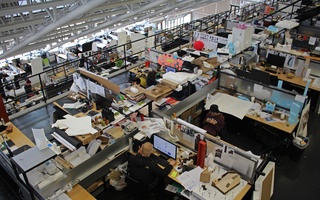Showcasing the work of more than 60 participating artists, the annual spring sale of the Ceramics Program of Harvard’s Office for the Arts opened in the program’s Allston studio on Thursday evening.
Patrons lined up outside the program’s space at 224 Western Ave. to browse handmade dishes, sculptures, and jewelry and to talk with the artists staffing the opening reception. The show will be open until May 10.
Founded in 1969 by a group of Harvard undergraduates, the Ceramics Program offers semester-long classes open to students and local residents. The program also hosts workshops for courses at the College and Graduate School of Design and events for students such as its “Clay All Night” parties.
Any of the 250 participants in courses offered by the program during the past semester have the opportunity to show their work at the spring sale. However, the program’s director of operations, Shawn L. Panepinto, said that most of the artists who do so are advanced ceramicists.
“We very rarely have Harvard students, whether they be undergraduates or graduate students, because they are usually on a beginner or intermediate level,” she said. “And they take everything home with them, so they don’t want to sell their work.”
One of the artists presenting works in the show, Newton resident Katherine Younger, has taken courses with the program since 2002 and described herself as a semi-professional ceramicist.
“I do sell my work, but I’m not really focused on sales,” she said. “I spend a lot of hours per week at the studio, but not enough to be a professional.”
Another of the artists featured in the show, Myrna Le Caill, said she appreciates the support that the Ceramics Program offers to non-professional artists.
“It’s a state-of-the-art studio and a state-of-the-art program, and the sense of community is great,” she said.
The program relocated to a newly renovated studio space in September 2013, a move that Panepinto said has transformed the annual show and sale.
“This is a much larger space, and it shows off the work to a much higher professional level,” she said. “Our numbers of people who come to the sale have increased, and our sales have increased.”
Panepinto herself worked with the architects on the design of the space, which had formerly served as a storage facility for Harvard’s recycling program. She said the new studio, with four large skylights and an open floor plan, represents an improvement on the program’s previous location in the basement level of 219 Western Ave. in Allston.
“I’ve seen people being so much more creative and so much happier here,” she said. “Production levels are way up.”
—Staff writer Elizabeth C. Keto can be reached at eketo@college.harvard.edu.
Read more in University News
Panel Objects to Hobby Lobby RulingRecommended Articles
-
 Renewed Recordings: Quad Sound Studios Serves Aspiring Musicians
Renewed Recordings: Quad Sound Studios Serves Aspiring Musicians -
 Business School Focuses on New Online Classroom Initiative
Business School Focuses on New Online Classroom Initiative -
 Design School Building Draws Praise, Except For the Desk Space
Design School Building Draws Praise, Except For the Desk Space -
 Thinking and Making: Matt Saunders on the Evolution of VES
Thinking and Making: Matt Saunders on the Evolution of VES -
A Smaller TableWe support the recent addition of restrictions with the hope that in the long term, the program is able to find new sources and continue to enrich our minds and our stomachs.













